F-35 Lightning aircraft from 617 Squadron set off from RAF Marham on a transatlantic flight to take part in Exercise Red Flag at Nellis Air Force Base in Nevada, the world’s premier air combat exercise.
The RAF say that the jets will initially land back at their former home at Marine Corps Air Station Beaufort in South Carolina before continuing their journey to Nellis Air Force Base.
Red Flag is a multinational combat training exercise which is conducted on the vast bombing ranges of the Nevada Test and Training Area. THe Ministry of Defence say that this will be the first time that the British F-35 Lightnings will have taken part in Exercise RED FLAG which will see them flying alongside a variety of aircraft from other nations to maximise combat readiness, capability and interoperability.
RAF Marham Station Commander, Group Captain Beck said in a release:
“This is another first for the Lightning Force and will give the opportunity for our pilots to really put the F-35s to the test in a combat representative environment. This training is as near to high-end operational flying as our pilots can get in a controlled environment and will really test them and the teams that support the Squadron.”
According to the US Air Force:
“A typical RED FLAG exercise involves a variety of attack, fighter and bomber aircraft (F-15E, F-35, F-16, F/A-18, A-10C, B-1B, B-2A, B-52H, FGR4, MQ-9, etc.), reconnaissance aircraft (MQ-4B, RC-135, U-2S), electronic warfare aircraft (EC-130H, EA-18G and F-16CM), air superiority aircraft (F-22A, F-15C, etc), airlift support (C-130, C-17A), Search and Rescue aircraft (HH-60G, HC-130J, CH-47), aerial refueling aircraft (KC-130, KC-135R, KC-10A, etc), multi-domain Command and Control platforms (E-3, E-8C, E-2C, E-7, R1, etc) as well as ground based Command and Control, Space, and Cyber Forces.”


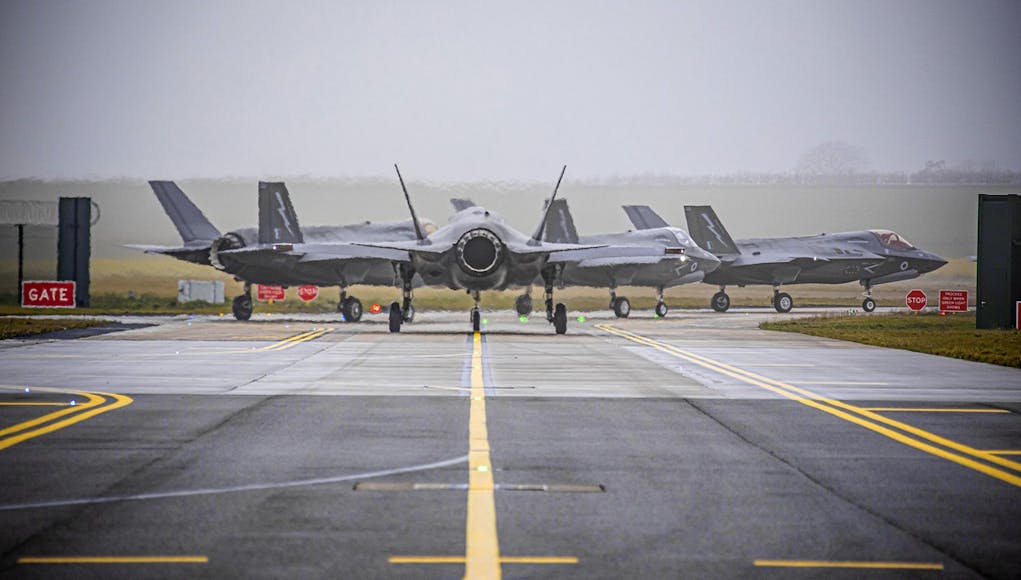




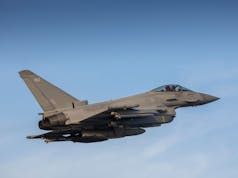

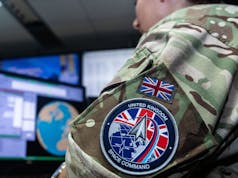
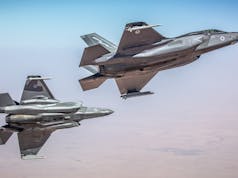
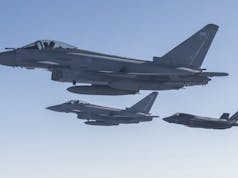


Is this the reason behind postponed/delayed QE sailing??
Hi Harry,
Queen Elizabeth sails tomorrow (25th) with 207 OCU aircraft. It’ll be the first time she has operated in home waters with UK F35’s embarked.
Bitter sweet news. No RAF Typhoons this time. Yes it’s good to keep 617 current, but there will be loads of F-35’s there. Will the 500+ Typhoons be represented this year?
To be fair with the recent upgrades to the RAF Typhoons including the integration of Meteor BVR… They may not want them there at all!
Would be bad news if they out performed the F35 in A2A role! 🙂
(I am being a little sarcastic… only a little though!)
My thoughts exactly. You can see plainly the F-35s don’t have the performance of a fighter. They’re more like highly capable flying computers who operate on a purely BVR shoot n’ scoot tactic. If two opposing pilots saw each other and engaged in a dogfight, F-35 wouldn’t stand a chance.
Let’s just hope we don’t fall for this one-sided design style. We should make the Tempest highly maneuverable but have the capabilities of very good stealth BVR.
I don’t think we will fall for it. F35 is basically replacing Harrier and Tornado, the latter being a purely strike role. Being stealth, they will have advantage over most adversaries we are likely to face in the air, but the real A2A muscle in the RAF is the Typhoon and after, Tempest.
Tempest will be our primary A2A platform, with F35 in a strike role.
Hi George, Based on historical evidence – four out of five pilots shot down in air combat never see the guy that does it. Dogfights are relatively rare. On that basis, F-35 might do very well – and I think it has wracked-up impressive kill-ratios in recent exercises. But I agree – the jury is out meantime.
I think the Typhoon-Lightning combo is potentially a good one – although I do wish we had another two squadrons of Tiffies!
I would really like to see how the Typhoons fair against the F-35 now that they have the new meteor missile along with better avionics. I don’t know if I truly believe the kill ratio numbers. I read somewhere the F-16s gave F-35s a pasting and then suddenly, within a few weeks it was proclaimed the F-35 achieved a 20/1 over F-16s. Granted its very early days yet so I don’t want to be too sceptical.
Pilot training is still in its infancy on the aircraft so we’ll know how effective this mass drone swarming and BVR tactic really is as opposed to high-performance 4th generation fighters.
I think you will find this story very interesting and should dampen your skepticism somewhat.
https://fighterjetsworld.com/air/f-16-shot-down-f-35a-at-red-flag/6137/
Hi George, I think that F-35 might have been an early model – and carrying a heavy load of test kit. Or at least, so I read!
I think the F-35’s performance figures on paper are nothing special – but if it really can detect another aircraft early, avoid detection, and then consistently get off the first-shot – it could be a stellar performer in the air-to-air arena.
The Germans are looking at a possible ECM variant of Typhoon. We should definitely get an extra squadron or two of that; even without stealth that would make them hard targets.
– 2 fighter/QRA squadrons
– 5 strike squadrons
– 1-2 ECM squadrons
Didn’t we used to have a Tornado squadron for maritime strike as well? Seems like something we should bring back.
Hi Steve, Yeah – Nos 12 and 617 squadrons, flying out of Lossiemouth, equipped with the Sea Eagle anti-shipping missile. Those Tornado units replaced the venerable Buccaneer in that role during the early Nineties.
Like you, I hope a German top-up buy of Typhoon might make a further British purchase attractive to the MoD.
Hard to believe that our “front-line” at the moment is essentially only seven squadrons of Tiffies.
Admittedly the F35 is not designed for dogfighting, but it is still quite capable. It most certainly is not a sitting duck during engagements. For starters, if out of visual range the F35 pilot has the option of disengaging and sneaking around the opposing aircraft. However, once in visual range the F35 pilot has three advantages over traditional aircraft. The first is the 360 degree EOTS, which will help prevent aircraft sneaking up on it. The other is the helmet mounted sighting system. This combined with the EOTS, allows the pilot to see through the aircraft, but also view the aircraft’s blind spots. The third advantage the F35 has is ASRAAM.
Its’s true ASRAAM isn’t quite in the same category as the knife fighting Iris-T, but it doesn’t need to be. The ASRAAM has a minimum of double the range of the Iris-T. It is also faster accelerating and has a higher top speed than its competitors. Therefore the F35 pilot can stay outside the engagement window of their opponent. Whilst their opponent, using missiles such as Python, Sidewinder, Iris-T or Adder will need to get inside the engagement zone of the ASRAAM, so they can close the distance to allow them to fire their missile. ASRAAM has a trick up its sleeve, it can lock on after launch. Therefore, if the pilot sees an aircraft behind but above/below them. They can target it through the helmet sight, launch the ASRAAM over/under their shoulder, without manoeuvring the aircraft towards their opponent, where the missile will then turn towards the target and then lock on to it, allowing the F35 to bug out.
In some respects the F35 should never have to dogfight with fitted with either Meteor or AMRAAM, but even with ASRAAM it still has a significant advantage over other aircraft. Especially when you combine that with its sensor fusion, data networking and inbuilt stealth.
I doubt this kind of system is exclusive to the F-35. The Russians have had helmet targeting systems for a long time. It’s a great platform to learn though. We can take the lessons learned and apply them to Tempest.
I think the best part of the F-35 will be how it interacts with satelites and drones as well as ships. Like I said, it’s basically a flying computer, but a very good one at that.
Have you even seen the latest flying demos the F-35s have done? They are as maneuverable as an F-16 or F-18.
Only with thrust vectoring and they bleed a ton of speed. They have slow acceleration compared to Eurofighter and F-16.
Their rolling take-offs are nothing impressive either. They do have an excellent hover system, superior to the Harrier for sure.
I wouldn’t be surprised if Typhoon did outperform F35 in air to air. Apart from stealth I don’t see any huge advantage an F35 would have over Typhoon in an air to air contest.
If we’re talking a WVR fight I’d rather be in Typhoon, personally.
I’ve seen the F-35 display at airshows and it’s quite embarrassing. I first thought they were taking it easy on the engines and airframes but after you’ve been to a few more, you realise that this is pretty much it.
It’s thrust to weight ratio is a step back not an improvement. It doesn’t have the turn rate to match an F-15 let alone a Eurofighter or F-16. It can’t carry as much ordanance as the Tornado but at least it has an internal bay. Overall I just think it’s a Jack of all trades, master of none. The proponents of the F/A-XX program have lamented the F-35 program and said that this kind of design philosophy should never be done again. Way over-budget and not that impressive. The stealth and avionics technology will be great but in terms of sheer fighter to fighter performance, its like something out of the 70s.
I’m not sure that an Airshow Display would show too much of the capability of the F35 and other Aircraft for that matter.The Displays are so safety regulated and are obviously choreographed to entertain crowds that I think reaching any boundaries in performance would be impossible.
It isn’t top trumps George. You don’t seem to grasp the advantages the F35 brings to the battle space. Every single pilot describes the aircraft as a absolute game changer in capability. Does it have the ultimate performance of a Typhoon or F22, no, it doesn’t. But it wasn’t designed to have that level of performance. An F16 with weapons and large external fuel tanks is limited to 5.5g. The F35A can still pull 9g with full internal fuel and weapons. That is it’s performance advantage over 4gen fighters in real world operations. Combine that with the all aspect stealth, the jets ISTAR capabilities, the 5th gen radar HMS and avionics, world beating situational awareness, which is what really wins fights, not how fast it can go or what it can do at an airshow. Although the F35A puts on a very impress display for an aircraft without thrust vectoring. And 15% of every single F35 built (over 3000) will be built in the UK.
Exactly, there is so much more to the Lightning than bomb/missile carrier. It’s an ISTAR hub and enabler, and while the pilot is concentrating on that, in a racetrack pattern, the aircraft and computer scan, identify and can engage targets without pilot interface! It’s a game changer mate for sure and as you say, not top trumps ( for those who remember them lol)
Lol, used to love a top trump card ? some people just seem transfixed with turn rate and back flips at airshows. Of course performance is still very important, but it’s a balance of airframe performance and avionic capabilities. RAF Tornado F3’s got valid kills back in 2007 against Indian airforce SU35’s due to the advantages of the AMRAAM/ASRAAM and JTIDS Link16 combination, and some very cunning tactics of course ? but it just shows you don’t need millennium falcon performance to win the fight ? top stuff.
I agree, Robert, having better “situation awareness” is the key factor in air combat.
Aviation historian, Mike Spick, is very good on this subject.
https://www.amazon.co.uk/gp/product/1853100137/ref=dbs_a_def_rwt_hsch_vapi_taft_p1_i4
Having the “ace factor” used to be something that few pilots possessed, but now technology is giving that ability to even your average fighter-jock.
If the F-35 lives up to the promises of its supporters, then its revolutionary SA could be a game-changer. I think it’s why so many western air-forces feel they can’t be without some examples in their fast-jet fleet.
Hi Alan, thanks for the link mate, I’ll check that out. Yeah I think we will work wonders with our F35’s, and mixed in with our Typhoons, we will have one of the most potent fighter combinations in the world, and with Tempest building steam, our future fast jet mix beyond 2040/50 looks assured.
I don’t think speed is a requirement when skin temperature pops you up on the enemy’s screen. And turning for home with that ruddy great flare on the back guarantees you that the pilot will be using as little as possible as they work to keep the heat out of it. The concern I have with the F-35 is that, once on a scope somewhere, it lacks the speed to exit theatre if under threat.
My comment is basically that, as a prolific aircraft type, and when F-15’s 16’s and 18’s continue to play a role, global tactics and training developed without the Typhoon in the mix, renders the whole exercise somewhat mute. If anything kicks off in the European theatre, the Typhoon pilots will be at a disadvantage.
First one of the year is normally just US aircraft plus RAF and RAAF…. Pity no typhoons. Would have been interesting to have F35 and T with meteor and ASRAAM combinations.
I was thinking exactly the same thing.UK Typhoons will offer something different whereas everyman and his dog will be in an f35. These airframes are certainly knocking up some air miles. How many transatlantic trips now and to think the operational fleet is still just 15? When are we getting another delivery?
Would there be much stress on the airframe loitering across the Atlantic?
possibly not but a lot of transit time
Uses up valuable Airframe hours.
They have enough airframe hours to last 30-40 years. We kept Tornado going(a 1970’s design) for 40 years, so no problem for the F35.
Might be some relevance here – https://www.thedrive.com/the-war-zone/26269/usmcs-older-f-35bs-may-only-be-able-to-fly-around-a-quarter-of-their-expected-service-life
Typhoons are attending Red Flag 20-1 now.
How about a ground based Red Flag with some of THESE involved?
https://www.thedrive.com/the-war-zone/31912/british-streetfighter-ii-tank-concept-has-x-ray-vision-and-is-all-about-the-urban-fight
Cheers
HI Helions,
Thanks for the link, I have read something about this programme somewhere before. Lots of really good ideas coming out of this little project and I bet that the soldiers really enjoyed themselves as well.
I did not realise that the latest upgrades took the weight to 82 tons! That is massive – what is the impact on mobility? Not good that’s for sure.
Urban fighting is pretty grim stuff (I can tell you from experience), especially for armor. This is a good clip of what it was like in 1945. Luckily the American crew had a brand new Pershing tank that was the equal of anything the Germans had.
https://www.youtube.com/watch?v=Ji-PGwxkk_g
Cheers
Respect to you Helions…
Second that, short range, confusing and violent.
BV
Thank you. Cheers to both of you!
This was interesting, can anyone shed more light on the incident?
However, RRR9401 (ZZ332) reportedly experienced fuel transfer issues that made the transatlantic crossing impossible and forced the “package” to land at Lajes Field.
https://theaviationist.com/2020/01/22/raf-f-35b-lightnings-bound-to-nellis-afb-for-their-first-red-flag-exercise-diverted-to-lajes/
Issue with the Voyager. These problems are rare, but these things can happen from time to time.
Nice joke ?